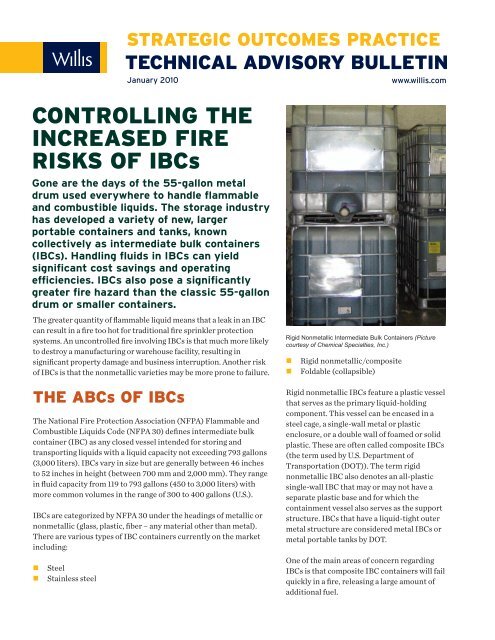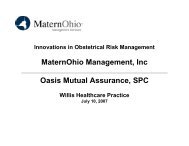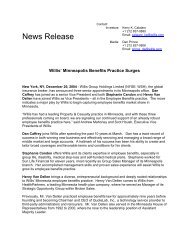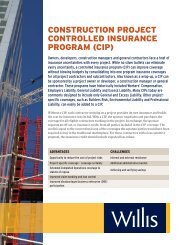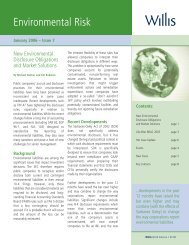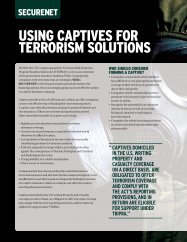CONTROLLING THE INCREASED FIRE RISKS OF IBCs - Willis
CONTROLLING THE INCREASED FIRE RISKS OF IBCs - Willis
CONTROLLING THE INCREASED FIRE RISKS OF IBCs - Willis
Create successful ePaper yourself
Turn your PDF publications into a flip-book with our unique Google optimized e-Paper software.
The greater quantity of flammable liquid means that a leak in an IBC<br />
can result in a fire too hot for traditional fire sprinkler protection<br />
systems. An uncontrolled fire involving <strong>IBCs</strong> is that much more likely<br />
to destroy a manufacturing or warehouse facility, resulting in<br />
significant property damage and business interruption. Another risk<br />
of <strong>IBCs</strong> is that the nonmetallic varieties may be more prone to failure.<br />
<strong>THE</strong> ABCs <strong>OF</strong> <strong>IBCs</strong><br />
The National Fire Protection Association (NFPA) Flammable and<br />
Combustible Liquids Code (NFPA 30) defines intermediate bulk<br />
container (IBC) as any closed vessel intended for storing and<br />
transporting liquids with a liquid capacity not exceeding 793 gallons<br />
(3,000 liters). <strong>IBCs</strong> vary in size but are generally between 46 inches<br />
to 52 inches in height (between 700 mm and 2,000 mm). They range<br />
in fluid capacity from 119 to 793 gallons (450 to 3,000 liters) with<br />
more common volumes in the range of 300 to 400 gallons (U.S.).<br />
<strong>IBCs</strong> are categorized by NFPA 30 under the headings of metallic or<br />
nonmetallic (glass, plastic, fiber – any material other than metal).<br />
There are various types of IBC containers currently on the market<br />
including:<br />
Steel<br />
Stainless steel<br />
STRATEGIC OUTCOMES PRACTICE<br />
TECHNICAL ADVISORY BULLETIN<br />
January 2010<br />
<strong>CONTROLLING</strong> <strong>THE</strong><br />
<strong>INCREASED</strong> <strong>FIRE</strong><br />
<strong>RISKS</strong> <strong>OF</strong> <strong>IBCs</strong><br />
Gone are the days of the 55-gallon metal<br />
drum used everywhere to handle flammable<br />
and combustible liquids. The storage industry<br />
has developed a variety of new, larger<br />
portable containers and tanks, known<br />
collectively as intermediate bulk containers<br />
(<strong>IBCs</strong>). Handling fluids in <strong>IBCs</strong> can yield<br />
significant cost savings and operating<br />
efficiencies. <strong>IBCs</strong> also pose a significantly<br />
greater fire hazard than the classic 55-gallon<br />
drum or smaller containers.<br />
Rigid nonmetallic/composite<br />
Foldable (collapsible)<br />
www.willis.com<br />
Rigid Nonmetallic Intermediate Bulk Containers (Picture<br />
courtesy of Chemical Specialties, Inc.)<br />
Rigid nonmetallic <strong>IBCs</strong> feature a plastic vessel<br />
that serves as the primary liquid-holding<br />
component. This vessel can be encased in a<br />
steel cage, a single-wall metal or plastic<br />
enclosure, or a double wall of foamed or solid<br />
plastic. These are often called composite <strong>IBCs</strong><br />
(the term used by U.S. Department of<br />
Transportation (DOT)). The term rigid<br />
nonmetallic IBC also denotes an all-plastic<br />
single-wall IBC that may or may not have a<br />
separate plastic base and for which the<br />
containment vessel also serves as the support<br />
structure. <strong>IBCs</strong> that have a liquid-tight outer<br />
metal structure are considered metal <strong>IBCs</strong> or<br />
metal portable tanks by DOT.<br />
One of the main areas of concern regarding<br />
<strong>IBCs</strong> is that composite IBC containers will fail<br />
quickly in a fire, releasing a large amount of<br />
additional fuel.
LISTED CONTAINERS<br />
NFPA 30 requires that nonmetallic or composite IBC<br />
containers be listed and labeled when used in protected<br />
buildings. The listing and labeling requirements are set by<br />
UL 2368 (Standard for Fire Exposure Testing of<br />
Intermediate Bulk Containers for Flammable and<br />
Combustible Liquids). Storage of liquids in non-listed IBC<br />
containers is classified by NFPA 30 as unprotected storage.<br />
DOT approves nonmetallic or composite IBC containers as<br />
Packing Group II containers UN 31H1 and UN 31H2 (rigid<br />
plastics) or UN 31HZ1 (composites). Containers must pass<br />
physical tests, e.g., pressure tests, drop tests, etc. It should<br />
be noted that explicit fire testing of containers is not<br />
performed for DOT approval.<br />
LIQUID EVALUATION<br />
Flammable liquids, mixtures, emulsions or semi-solids<br />
stored in <strong>IBCs</strong> must have their flash points and/or fire<br />
points measured. Classifications per NFPA 30 are:<br />
Class I (Flammable Liquid) flashpoint below 100°F<br />
(37.8°C)<br />
Class II (Combustible Liquid) flashpoint at or above<br />
100°F (37.8°C) and below 140°F (60°C)<br />
Class IIIA (Combustible Liquid) flashpoint at or above<br />
140°F (60°C), but below 200°F (93°C)<br />
Class IIIB (Combustible Liquid) flashpoint at or above<br />
200°F (93°C)<br />
<strong>FIRE</strong> TESTS<br />
A fire test project was initiated in 1995 by the National Fire<br />
Protection Research Foundation (NFPRP) with the aim of<br />
improving fire protection associated with the storage of<br />
flammable and combustible liquids in non-metallic <strong>IBCs</strong>.<br />
Phases I and II of the project were conducted to develop<br />
protection designs for the palletized storage of flammable<br />
and combustible liquids.<br />
The object of Phase I was to identify where and in what time<br />
period commercially available <strong>IBCs</strong> would fail when<br />
exposed to a hydrocarbon fire. The fire tests were<br />
conducted with a 10-gallon heptane spill fire and a 2-gpm<br />
heptane running fuel fire. The tests were conducted with a<br />
30-minute fire exposure. The tests showed that non-listed<br />
non-metallic IBC units may fail rapidly (in as little as three<br />
minutes) when protected by water sprinklers and subjected<br />
to a pan fire.<br />
2<br />
A follow-up effort (Phase II) was initiated to<br />
conduct large-scale fire tests representing<br />
real-world storage/use scenarios. The<br />
objective was to investigate fire<br />
control/suppression capabilities of fixed fire<br />
suppression systems on an array of <strong>IBCs</strong><br />
stacked both one and two containers high.<br />
The variables investigated included the<br />
design of the fire suppression system, the<br />
storage configuration array and the type of<br />
<strong>IBCs</strong> in the array.<br />
The results of the Phase II tests suggested<br />
that combining fire resistant IBC design with<br />
appropriate water sprinkler protection can<br />
control a fire in the tested storage array.<br />
Additional fire testing in a Phase III study<br />
examined water sprinkler protection criteria<br />
contained in NFPA 30 for large metal<br />
containers stored in racks. For additional<br />
information please refer to the NFPA<br />
website.<br />
Factory Mutual (FM) reports on tests<br />
comparing a wide variety of plastic and<br />
composite <strong>IBCs</strong>. According to their FM Loss<br />
Prevention Data Sheet 7-29 (Flammable<br />
Liquid Storage in Portable Containers)<br />
Section 3.6.5.1, a series of scoping and<br />
intermediate scale fire tests looked at the<br />
general performance of <strong>IBCs</strong> when exposed to<br />
pool fires and spill fires with the hope of<br />
developing a standard test that could be used<br />
to evaluate the fire performance of any IBC.<br />
The test results showed significant<br />
differences in the fire performance of the<br />
tested units, and highlighted the need for<br />
additional performance testing to determine<br />
which units should be used for flammable<br />
liquid storage. FM concluded that additional<br />
research is needed to finalize a method for<br />
evaluating the fire performance of <strong>IBCs</strong>.<br />
Copies of FM Data Sheet 7-29 and other FM<br />
data sheets are now available for download at<br />
no charge upon registration with FM. For<br />
further information please refer to the FM<br />
Global website.<br />
<strong>Willis</strong> North America • 01/10
PROTECTION<br />
NFPA 30 addresses the requirements for the protection of metal,<br />
rigid nonmetallic and composite <strong>IBCs</strong> stored either palletized<br />
and/or in single and/or double row racks. The standard does not<br />
allow the protected storage of protected Class I flammable liquids<br />
(flashpoint below 100°F (37.8°C)) in rigid nonmetallic or composite<br />
containers. NFPA 30 contains protection schemes only for the<br />
storage of Class II and III combustible liquid materials in listed rigid<br />
nonmetallic or composite type <strong>IBCs</strong>.<br />
Factory Mutual (FM) currently provides protection requirements<br />
for metal containers holding more than 60 gallons (including metal<br />
<strong>IBCs</strong>) palletized or in solid pile storage. FM may soon provide<br />
protection requirements for the storage of low flashpoint liquids in<br />
metal IBC containers in racks.<br />
Proven protection schemes are not currently available for flammable<br />
and combustible liquids stored in nonmetallic <strong>IBCs</strong>, according to<br />
FM. FM states that the recommended protection for flammable<br />
liquids in plastic or glass containers greater than 6.5 gallons (25<br />
liters) in Loss Prevention Data Sheet 7-29 will not prevent the<br />
consumption of all of the liquid stored in the cutoff room or building.<br />
The large quantity of liquid in a single container greatly increases<br />
the potential for a large spill fire that could activate all of the<br />
sprinklers in the cutoff room or building.<br />
For unprotected storage using rigid nonmetallic or composite IBC<br />
containers, NFPA 30 poses storage limitations as to the maximum<br />
storage height, maximum gallons per pile and maximum total<br />
storage quantity. See Table 12.6.2.2 of NFPA 30 (2008).<br />
For protected palletized storage of listed rigid nonmetallic IBC<br />
containers containing Class II and III combustible liquids, NFPA 30<br />
provides sprinkler protection design criteria for both one and two<br />
container high storage in Table 16.5.2.9 NFPA 30 (2008).<br />
3<br />
For protected single and/or double rack<br />
storage of listed rigid nonmetallic IBC<br />
containers containing Class II and III<br />
combustible liquids, NFPA 30 provides<br />
sprinkler protection design criteria for<br />
maximum 25-foot storage in a building with<br />
maximum ceiling height of 30 feet. Please<br />
refer to Table 16.5.2.10 NFPA 30 (2008).<br />
PROTECTION<br />
ALTERNATIVES<br />
Protection alternatives should always be<br />
investigated (i.e., possible use of off-site IBC<br />
storage facilities, etc.).<br />
The indoor storage of flammable or<br />
combustible liquids in nonmetallic or<br />
composite <strong>IBCs</strong> in plant production or<br />
warehouse storage areas should be<br />
prohibited.<br />
Attempt to store <strong>IBCs</strong> at a supplier<br />
location and receive the materials on a<br />
just-in-time basis.<br />
Consider alternatives such as designing<br />
and installing a properly protected bulk<br />
storage and piping system.<br />
Consider the use of steel 55-gallon drums<br />
or steel <strong>IBCs</strong>.<br />
Determine if nonmetallic or composite<br />
<strong>IBCs</strong> are the only method for receiving<br />
and storing flammable and combustible<br />
liquids in your plant.<br />
<strong>Willis</strong> North America • 01/10
If the storage of nonmetallic or composite <strong>IBCs</strong> is necessary,<br />
they should be stored off-site or in detached, contained storage<br />
areas away from the plant or in commercially available<br />
flammable or combustible liquids storage structures designed<br />
for handling <strong>IBCs</strong>.<br />
If the only option is storage of nonmetallic or composite <strong>IBCs</strong> in<br />
the plant, consider minimizing the storage within the key areas<br />
of the plant to one IBC tote in widely separated dispensing or<br />
end use areas. Provide adequately sized containment areas or<br />
high-sided steel containment designed to prevent the sudden<br />
release of liquid. IBC totes should be provided with a double<br />
block to provide spill protection from potential damage to the<br />
dispensing valve.<br />
Isolate the storage of nonmetallic or composite <strong>IBCs</strong> from steel<br />
drums containing other combustible or flammable liquids.<br />
If necessary, the interior storage of <strong>IBCs</strong> should be limited to<br />
rooms with minimum two-hour fire resistance-rated<br />
construction and equipped as flammable or combustible liquids<br />
rooms as outlined in NFPA 30 and FM Data Sheet 7-29. Such<br />
rooms typically include adequate spill containment and/or<br />
drainage, automatic sprinkler protection and perhaps the use of<br />
AFFF foam protection.<br />
ADDITIONAL INFORMATION<br />
For additional information on the storage and handling of flammable<br />
and combustible liquids please refer to the following:<br />
National Fire Protection Association (NFPA) Flammable and<br />
Combustible Liquids Code (NFPA 30)<br />
Factory Mutual Loss Prevention Data Sheet 7-29 (Flammable<br />
Liquid Storage in Portable Containers)<br />
4<br />
COST VS. SAFETY<br />
As previously noted, the handling of liquids in<br />
<strong>IBCs</strong> can yield significant cost savings and<br />
operating efficiency; however, the fire hazard<br />
posed by such large volumes of flammable<br />
and combustible liquids has been determined<br />
by fire tests to be more severe than the hazard<br />
posed by the storage and handling of<br />
traditional 55-gallon drum and/or smaller<br />
capacity containers. We recommend that you<br />
discuss any proposed plans or existing<br />
storage situations for flammable and<br />
combustible liquids with a Property Risk<br />
Control consultant before reaching a final<br />
decision.<br />
CONTACTS<br />
If you would like additional information on<br />
this or other risk control topics, contact your<br />
local <strong>Willis</strong> Property Risk Control<br />
representative or:<br />
Alan Dopart, PE, CSP<br />
Senior Property Risk Control Consultant<br />
<strong>Willis</strong> Strategic Outcomes Practice<br />
973 829 2916<br />
alan.dopart@willis.com<br />
Joe Stavish, PE<br />
National Technical Director<br />
Property Risk Control<br />
<strong>Willis</strong> Strategic Outcomes Practice<br />
973 829 2955<br />
joe.stavish@willis.com<br />
The objective of our publication is to provide a<br />
general overview and discussion of issues relevant<br />
to loss control. The comments and suggestions<br />
presented should not be taken as a substitute for<br />
advice about any specific situation.<br />
<strong>Willis</strong> North America • 01/10


